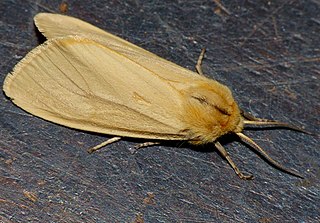
Ceryx is a genus of moths in the family Erebidae. It was described by Hans Daniel Johan Wallengren in 1863.

Saenura is a genus of moth in the subfamily Arctiinae. It contains only one species, Saenura flava, which can be found in southern Africa.
Siccia is a genus of moths in the family Erebidae. The genus was erected by Francis Walker in 1854.

Piletocera is a genus of moths of the family Crambidae. The genus was first described by Julius Lederer in 1863.
Colpocheilopteryx is a monotypic moth genus of the family Euteliidae. Its only species, Colpocheilopteryx operatrix, is found in the Democratic Republic of the Congo, South Africa, Zambia and Zimbabwe. Both the genus and species were first described by Hans Daniel Johan Wallengren, the genus in 1865 and the species five years earlier in 1860.

Plecopterodes is an Afrotropical genus of moths of the family Erebidae.
Homoeomeria is a genus of moths in the subfamily Lymantriinae. The genus was erected by Hans Daniel Johan Wallengren in 1865.

Odontocheilopteryx is a genus of moths in the family Lasiocampidae. The genus was first described by Wallengrenin 1860.
Acontia gratiosa is a moth of the family Noctuidae first described by Hans Daniel Johan Wallengren in 1856.
Antihepialus antarcticus is a species of moth of the family Hepialidae. It is known from South Africa.

Ozarba corniculans is a moth of the family Noctuidae. The species was first described by Hans Daniel Johan Wallengren in 1860. It is found in Kenya, Zimbabwe, South Africa and Madagascar.
Micralarctia punctulatum is a moth of the family Erebidae. It was described by Hans Daniel Johan Wallengren in 1860. It is found in Angola, Botswana, Cameroon, the Democratic Republic of the Congo, Eritrea, Ethiopia, Ghana, Kenya, Malawi, Mozambique, Namibia, Niger, Nigeria, Senegal, South Africa, Tanzania, Gambia, Uganda, Zambia and Zimbabwe.
Ceryx burtti is a moth of the subfamily Arctiinae. It was described by William Lucas Distant in 1900. It is known from Pemba Island, Tanzania.
Tachosa fumata is a moth of the family Erebidae first described by Hans Daniel Johan Wallengren in 1860. It is found in Angola, Burkina Faso, the Democratic Republic of the Congo, Ethiopia, Kenya, Mauritania, Namibia, South Africa, Tanzania, Uganda and Zimbabwe.
Piletocera flavalis is a moth in the family Crambidae. It was described by George Hampson in 1917. It is found in Malawi.

Marmaroplegma paragarda, the speared monkey, is a moth in the family Eupterotidae. It was described by Wallengren in 1860. It is found in South Africa and Zimbabwe.






